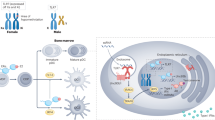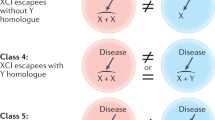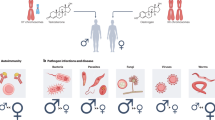Abstract
IN mammals, the genetic basis of sex determination and differentiation seems to be simple1,2. A gene or set of genes on the Y chromosome causes the indifferent embryonic gonad to develop as a testis3. Thus an ovary develops in the absence of the Y and a testis in its presence. The testis then secretes testosterone which induces male development of the accessory glands and ducts4,5. The masculinising action of testosterone on its target cells is mediated by the product of a gene on the X chromosome. This product activates all the genes required for manifestation of the male phenotype in response to circulating testosterone1. Evidence for this crucial involvement of the X chromosome in male sexual differentiation comes from a mutation of the relevant gene in the mouse (Tfm), resulting in failure to respond to testosterone. A chromosomally XY animal with this mutant gene develops testes, because the Y chromosome is present, but shows no further male differentiation, thus exhibiting the syndrome known as ‘testicular feminisation’6. This insensitivity to androgen is caused by a mutational deficiency of the nuclear–cytosol androgen-receptor protein not only in mice7–9 but also in man10. Thus the part that the X chromosome plays in male sexual differentiation has been clarified at the level of an individual gene situated on this chromosome.
This is a preview of subscription content, access via your institution
Access options
Subscribe to this journal
Receive 51 print issues and online access
$199.00 per year
only $3.90 per issue
Buy this article
- Purchase on Springer Link
- Instant access to full article PDF
Prices may be subject to local taxes which are calculated during checkout
Similar content being viewed by others
References
Ohno, S., Nature, 234, 134–137 (1971).
Lyon, M. F., Proc. R. Soc., B 187, 243–268 (1974).
Welshons, W. J., and Russell, L. B., Proc. natn. Acad. Sci. U.S.A., 45, 560–566 (1959).
Jost, A., Phil. Trans. R. Soc., B 259, 119–130 (1970).
Price, D., Phil. Trans. R. Soc., B 259, 133–139 (1970).
Lyon, M. F., and Hawkes, S. G., Nature, 227, 1217–1219 (1970).
Gehring, U., Tomkins, G. M., and Ohno, S., Nature new Biol., 232, 106–107 (1971).
Attardi, B., and Ohno, S., Cell, 2, 205–212 (1974).
Gehring, U., and Tomkins, G. M., Cell, 3, 59–64 (1974).
Keenan, B. S., Meyer, W. J., Hadjian, A. J., Jones, H. W., and Migeon, C. J., J. clin. endocr. Metab., 38, 1143–1146 (1974).
Jacobs, P. A., and Ross, A., Nature, 210, 352–354 (1966).
Eichwald, E. J., and Silmser, C. R., Transplantn. Bull., 2, 154–155 (1955).
Gasser, D. L., and Silvers, W. K., Adv. Immun., 15, 215–247 (1972).
Wachtel, S. S., et al., Proc. natn. Acad. Sci. U.S.A., 71, 1215–1218 (1974).
Wachtel, S. S., Koo, G. C., and Boyse, E. A., Nature, 254, 270–272 (1975).
Cattanach, B. M., Genet. Res., 3, 487–490 (1962).
Ferguson-Smith, M. A., J. med. Genet., 2, 93–156 (1965).
Cattanach, B. M., Pollard, C. E., and Hawkes, S. G., Cytogenetics, 10, 318–337 (1971).
Author information
Authors and Affiliations
Rights and permissions
About this article
Cite this article
WACHTEL, S., OHNO, S., Koo, G. et al. Possible role for H–Y antigen in the primary determination of sex. Nature 257, 235–236 (1975). https://doi.org/10.1038/257235a0
Received:
Accepted:
Issue Date:
DOI: https://doi.org/10.1038/257235a0
This article is cited by
-
Geschlechtsdetermination und Entwicklung der Genitalorgane
Der Urologe B (1997)
-
Molecular basis governing primary sex in mammals
Japanese Journal of Human Genetics (1996)
-
Female anti-male attack
Nature (1995)
-
Die Genetik der menschlichen Geschlechtsdetermination und ihre St�rungen
Naturwissenschaften (1994)
-
Putting the heat on sex determination
Genetica (1992)
Comments
By submitting a comment you agree to abide by our Terms and Community Guidelines. If you find something abusive or that does not comply with our terms or guidelines please flag it as inappropriate.



